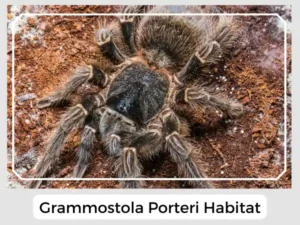Say hello to the Grammostola porteri spider. This cool tarantula makes its home in South America. Many people love having them as pets because they’re so special. Ready to explore and learn more about this popular spider buddy?
Female spiders of this species lay around 50-2000 eggs in a sac made of webbing.
They are light pink initially before molting to resemble the adults.
These spiders don’t use webs to catch prey. However, they spin silk threads around their burrow to detect intruders.
Yes, Grammostola porteri tarantulas have venom. They use it to grab their food. But don’t worry, for most people, the venom isn’t very strong.
They can indeed! While they’re often calm, if they feel cornered, they might give a little bite. It’s always a good idea to give them space.
The Grammostola porteri tarantula is an important biological control agent, managing populations of insects and other small invertebrates. Their predatory behavior ensures the stability of the ecosystem.
Natural Predators: In the wild, they face threats from larger animals, such as birds of prey, which help maintain the natural order by keeping their numbers in check.
Prey-Predator Dynamics: Through their predation, these tarantulas contribute to the regulation of prey species, which might otherwise become overabundant and cause ecological imbalance.
Relationship with Humans: Often kept as pets due to their placid nature, the Grammostola porteri reflects a remarkable example of wildlife domestication. They’re generally safe around humans, emphasizing the need for responsible pet ownership and conservation of their natural habitats.
| Other names | Common Rose hair tarantula, Chilean tarantula (both nicknames are more commonly assigned to Grammostola rosea) |
| Lifespan | Males: 5 years, Females: 20-30 years |
| Distribution | Argentina, Bolivia, and Chile |
| Habitat | Scrublands |
| Diet | Beetles, crickets, grasshoppers, moths, and worms |

In summary, the Grammostola porteri tarantula embodies the diverse and intriguing spider fauna of South America.
Say hello to the Grammostola porteri spider. This cool tarantula makes its home in South America. Many people love having them as pets because they’re so special. Ready to explore and learn more about this popular spider buddy?
Female spiders of this species lay around 50-2000 eggs in a sac made of webbing.
They are light pink initially before molting to resemble the adults.
These spiders don’t use webs to catch prey. However, they spin silk threads around their burrow to detect intruders.
Yes, Grammostola porteri tarantulas have venom. They use it to grab their food. But don’t worry, for most people, the venom isn’t very strong.
They can indeed! While they’re often calm, if they feel cornered, they might give a little bite. It’s always a good idea to give them space.
The Grammostola porteri tarantula is an important biological control agent, managing populations of insects and other small invertebrates. Their predatory behavior ensures the stability of the ecosystem.
Natural Predators: In the wild, they face threats from larger animals, such as birds of prey, which help maintain the natural order by keeping their numbers in check.
Prey-Predator Dynamics: Through their predation, these tarantulas contribute to the regulation of prey species, which might otherwise become overabundant and cause ecological imbalance.
Relationship with Humans: Often kept as pets due to their placid nature, the Grammostola porteri reflects a remarkable example of wildlife domestication. They’re generally safe around humans, emphasizing the need for responsible pet ownership and conservation of their natural habitats.
| Other names | Common Rose hair tarantula, Chilean tarantula (both nicknames are more commonly assigned to Grammostola rosea) |
| Lifespan | Males: 5 years, Females: 20-30 years |
| Distribution | Argentina, Bolivia, and Chile |
| Habitat | Scrublands |
| Diet | Beetles, crickets, grasshoppers, moths, and worms |

In summary, the Grammostola porteri tarantula embodies the diverse and intriguing spider fauna of South America.